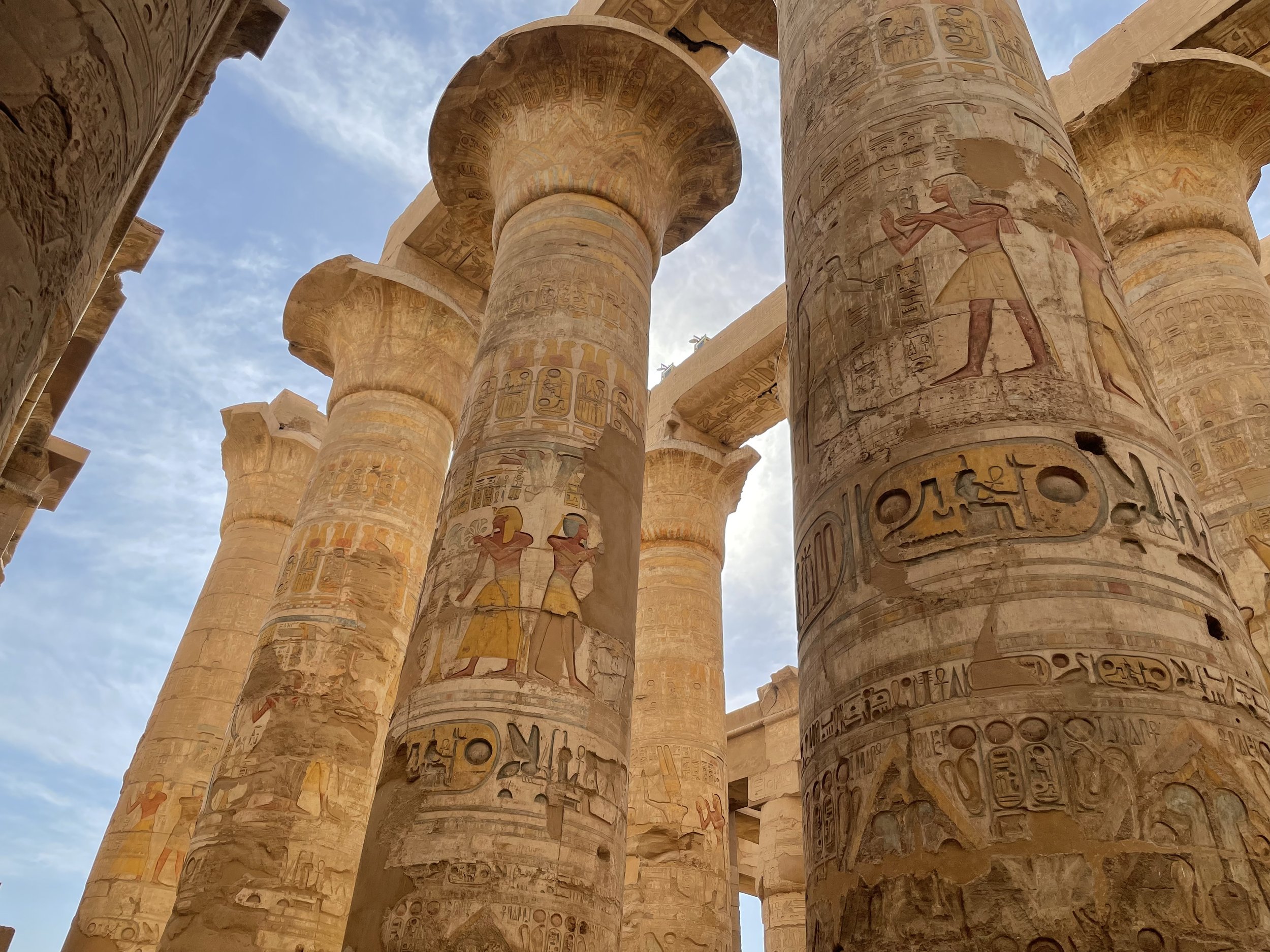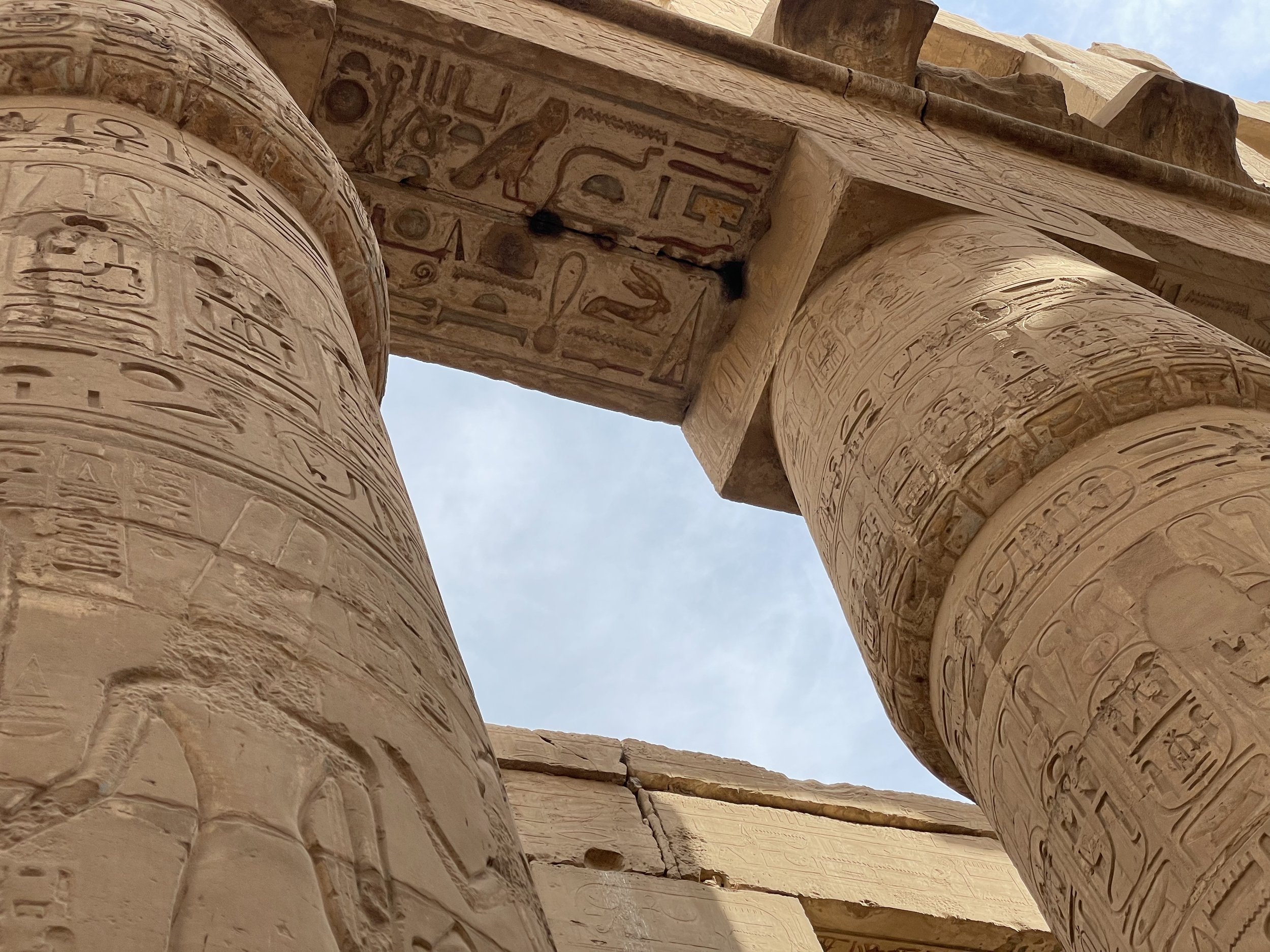Karnak Temple
Hank Schrader, USMA '71, Europe Destination & Europe River Cruise Expert
Anne Schrader, Certified Travel Counselor & Certified Luxury Cruise Specialist
This week, I thought I’d write about our visit to Karnak Temple.
We toured the temple complex as part of our AmaWaterways Secrets of Egypt and the Nile AmaWaterways cruise in December 2021.
So, let’s explore together and learn about Karnak Temple—you won’t be disappointed!
Overview
Karnak Temple is impressive. It was the most important site in ancient Thebes in the New Kingdom (it is now called Luxor).
The size and display of power in the complex is daunting today and must have been overwhelming in ancient Egypt to any person who came to visit or worship. It is the largest ancient religious site in the world. 30 pharaohs contributed to construction of this site.
According to the Temple Map plan, there are 34 different sites that could be visited on these grounds. Our tour took us to the most important and impressive parts of the complex.
Egyptian Temples were used to worship the gods and to ensure the people knew the pharaohs were also gods associated with their gods.
This temple complex honors Amon, the god of fertility and growth; Mut, the wife of Amon; whose symbol is the vulture, and Montu, the god of war.
Each god has its own area, known as precincts. Karnak is so vast, much of the complex has not been fully explored and many projects are on going to study this ancient area.
The gods honored at Karnak
Amon, also known as Amon, Ammon, Amen, and Amun-Ra. Amun was the Egyptian god of the sun and air. He is usually depicted as a bearded man with a headdress or later as a ram headed man or just a ram (a symbol of fertility). He is considered the lord of all and involved in every aspect of creation.
This is an excellent depiction of 2 of the gods. On the far left is Mut; in the center is Amun-Ra (note the twin headdress); and on the right is Ramses II worshiping both gods.
Mut, also known as Maut and Mout, was the great divine mother and sky goddess. She was believed to have given birth to the world. She is depicted as a woman with wings and a headdress, as a vulture and sometimes as a cobra.
Montu, is the falcon-headed god of war. He is depicted as a falcon-headed man or a bull-headed man and a solar disk, denoting his link to Ra, the sun god.
Along with the worship of the gods, it was important for pharaohs to be associated with worship of the gods and often depicted as equals—they were the political adds of the day when most could not read or write but could grasp symbols.
The Entrance to the Complex
The entrance walls to the complex are close to 90 feet high. On the site map it is designated as pylon 1. A pylon is a term used to describe the front wall of an Egyptian Temple. Usually, it has elaborate carvings and a gateway.
The carvings on the pylons show scenes of the ruler who built them. 6 pylons face west towards the Nile River. 4 pylons face south and were used for the ceremonial processional route to link Karnak with Luxor Temple (which was also included in our cruise tour). Just recently, with great fanfare, Egypt has open the route of the ram-headed sphinxes and we got to see parts of this route traveling on our coach between sites.
The Ram-headed statues line the entrance way to the 1st pylon.
The first pylon entrance to the temple complex.
The entrance to this area is lined with ram-headed sphinx statues.
The ram-headed statues line the entrance way on both sides.
The ram was the symbol of the god Amun and was the main god worshiped at the Great Temple of Karnak.
A close up of a ram-headed statue.
The Precinct of Amun
This area has the most famous parts of Karnak. Inside the 1st wall (pylon), we first visited the Temple of Sety I. The chapel areas often held Egyptian barks, which were designed to transport statues of gods or mummys in processions.
Here are some photos:
The Chapels of Sety II. From left to right, the first chapel door is dedicated to Mut, the second chapel door is dedicated to Amun and the right chapel door is dedicated to Khonsu (the moon god and son of Amum and Mut). These were designed to hold barks for celebrations of these gods.
Ceremonial Barks on display at the Karnak visitors’ center
The Temple of Amon, with the ram-headed statues in front of the temple.
Next was the Pavilion of Taharqa and the Temple of Ramses III. They were in the Bubastite Courtyard.
Statue of Ramses III
By far for me, the most impressive par of Karnak, was the fascinating Great Hypostyle Hall. We reached this amazing area after going through the 2nd pylon.
The 2nd Pylon at Karnak
Wall detail on the 2nd pylon at Karnak
Great Hypostyle Hall.
This area is about 337 feet by 170 feet. There are 134 columns decorated with hieroglyphs. The largest 12 columns are 70 feet high. These massive columns supported a roof which is no longer there.
The larger columns still have vibrant colors
Anne captured some great detail of one of the columns in this picture. Starting from the top the second row of symbols are cartouches. Cartouches are ovals or oblong circles enclosing a group of hieroglyphs which represent the name of the ruling pharaoh. On the third row, the pharaoh is making an offering to the gods.
The remaining 122 columns are about 40 feet high.
Amazingly many of the columns have vibrant colors that are over 3500 years old and remain as colorful as when they were first painted.
Even the roof was decorated with inscriptions and hieroglyphs.
Our AmaWaterways Egyptologist explains facts about the columns. This picture shows the massive columns in rows and gives you a sense of how large this area is.
.Obelisks
We next went past the pylon and got a wonderful view of the remaining Obelisks of Thutmose I . Originally, there were 2, a tribute to the great warrior king, who extended his kingdom south in Nubia and north into Syria.
Obelisks were monuments to honor the gods, commemorate the dead and represents the pharoahs.
Next past the 4th pylon to the Obelisk of Hatshepsut (the tallest obelisk in the picture below). This obelisk was built in 1457 BC and is the second biggest of all the ancient obelisks built in Egypt—it weighs 343 tons and stands 97 feet tall.
The largest obelisk from ancient Egypt is in Rome at the Lateran Palace; the third largest is in St. Peter’s Square in the Vatican (Caligula’s Obelisk).
Caligula’s Obelisk in Vatican Square—the 3rd largest obelisk taken from Egypt
Just in case you are wondering, the largest obelisk in the world is the Washington Monument—as many of you know, you can go to the top of this obelisk for wonderful views of Washington, D.C,, as I did as a child growing up in the D.C, area..
Another great picture from Anne, showing both obelisks—it is easy to see how massive they are!
The final part of our visit was to turn towards south, through some smaller temples and pylons. Here are two areas we saw as we walked towards the scared lake and out of the temple complex area.
Pointing out the inscriptions on this smaller pillar. It was very easy to see the Egyptian hieroglyphs on this small pillar.
Our Final Thoughts
We hope you enjoyed this report. This is a fascinating place and deserves a visit for most serious travelers—it certainly makes most bucket lists.
We are travel experts, ocean and river cruise specialists, and Europe destination experts. We have first-hand knowledge of anywhere you want to visit in Europe. We know our products and the vendors who sell them to you. We have designed special tours for dozens of clients, led several and will continue to find just the right vacation that will exceed your expectations.
When you are spending your hard-earned money for a vacation, you want an advisor who can match you with the right trip. You want someone who will understand your expectations and fuel your anticipation (or excitement) to get you the best possible trip experience. And, you want someone who can help you with the decision making process. We think we have all these qualities.
Whatever your Dream Destinations are, we are here to help you get the best possible vacation based on what is important to you! We will provide you high quality, expertly planned travel. Please give me a call 713-397-0188 (Hank) or email me at hschrader@dreamdestinations.com. We want to help you: Savor life…make memories…Visit Dream Destinations! Your journey begins here!
ANNE has earned a degree from the University of Houston in Hotel and Restaurant Management. Serving as the President of Visit Dream Destinations, LLC, since 2016, she is uniquely experienced professional travel advisor with over 26 years’ experience in the travel industry. Among her numerous certifications, she is a Certified Travel Counselor (CTC) by the Travel Institute, considered the gold standard in travel agent certification and she is also an Accredited Cruise Counselor (ACC) by the Cruise Lines International Association (CLIA), as well Luxury Cruise Specialist also from CLIA. Having traveled often to Europe since 1989, she has expanded on her certification as a Destination Specialist in Western Europe (DS) with extensive first-hand experience in luxury vacations. She holds numerous other specialty designations from individual vendors. An expert photographer, she delights in capturing the true essence of destinations to share with all.
HANK is a certified Western European Destination Specialist (DS) who has been traveling to Europe for 50 years. He is also an Accredited Cruise Counselor (ACC), conferred by the Cruise Line International Association (CLIA). This recognized expert in cruise and leisure travel is a retired Army Officer, and taught World Geography for 8 years. He is a `71 graduate of West Point and has earned 2 master’s degrees. His other Certifications:
AmaWaterways River Cruise Specialist
Viking River Cruise Specialist
Scenic River Cruise Specialist
Emerald Waterways Specialist
Avalon Waterways Specialist
Brit Agent

























